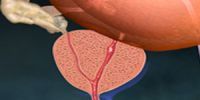Free Testosterone May Dictate Necessary Treatment in Prostate Cancer
Research from Chile suggests that low levels of free testosterone - rather than high ones - indicate that an apparently low-risk case of prostate cancer will require treatment.

Research from Chile suggests that low levels of free testosterone — rather than high ones — indicate that an apparently low-risk case of prostate cancer will require treatment.
Researchers from the Pontificia Universidad Católica de Chile studied 154 men whose prostate cancer qualified for active surveillance rather than treatment.
The 54 men (35%) whose cancer eventually required active treatment had significantly lower starting free testosterone levels than those whose cancer was not reclassified and treated (0.75 vs 1.02 ng/dL, P = 0.03).
Men with free testosterone levels <0.45 ng/dL had a higher rate of disease reclassification than patients with free testosterone levels ≥0.45 (P = 0.032). Indeed, free testosterone levels <0.45 ng/dL were associated with a several-fold increase in the risk of disease reclassification (OR 4.3, 95% CI 1.25—14.73).
“These results suggest low levels of testosterone are associated with more aggressive prostate cancer. This contradicts long-held beliefs that high testosterone is risky for prostate cancer, and low testosterone is protective,” said the study’s lead author, Ignacio San Francisco, MD.
Other than free testosterone levels, the researchers saw no significant differences among the men whose cancer eventually needed treatment and those whose cancer never did. The 2 groups had comparable mean age, prostate-specific antigen (PSA), PSA density, body mass index, and prostate volume.
Even total testosterone levels were comparable. It was only the free testosterone that varied. (Lower total testosterone levels did, actually, increase the risk for patients, but the numbers did not quite reach the level of statistical significance.)
Researchers used receiver—operator curves to identified a free testosterone level of 0.45 ng/dL as the most appropriate threshold for further analyses — and the results were significant.
Among men with free testosterone levels >0.45 ng/dL (P = 0.035), 36 of 98 moved from surveillance to treatment.
Among men with free testosterone levels <0.45 ng/dL, 9 of 13 did.
After finding that very low levels of free testosterone increased the odds that prostate cancer would eventually require treatment, the researchers looked to see whether high levels created any protective effect, but none was found.
The researchers acknowledged several limitations in their study, limitations such as the reasonably small cohort and the fact that free and total testosterone figures were available for most but not all of the men.
Moreover, they wrote, the limitations of retrospective analysis prevented them from analyzing things like sex-hormone binding globulin (SHBG), luteinizing hormone, and oestradiol, which affect testosterone physiology.
Still, they think the study may provide some practical benefit.
Active surveillance is an increasingly popular option for men with low-risk cases of prostate cancer. Eventually, however, about a third of cases worsen to the point where treatment is needed.
The ability to identify which cases are most likely to progress — and treat them earlier — could improve outcomes, and the authors of this study think they may well have found a valuable tool in making such predictions.
“In borderline cases,” San Francisco said, “the presence of low values of free testosterone may help determine whether it is more prudent to initiate treatment rather than continue observation.”